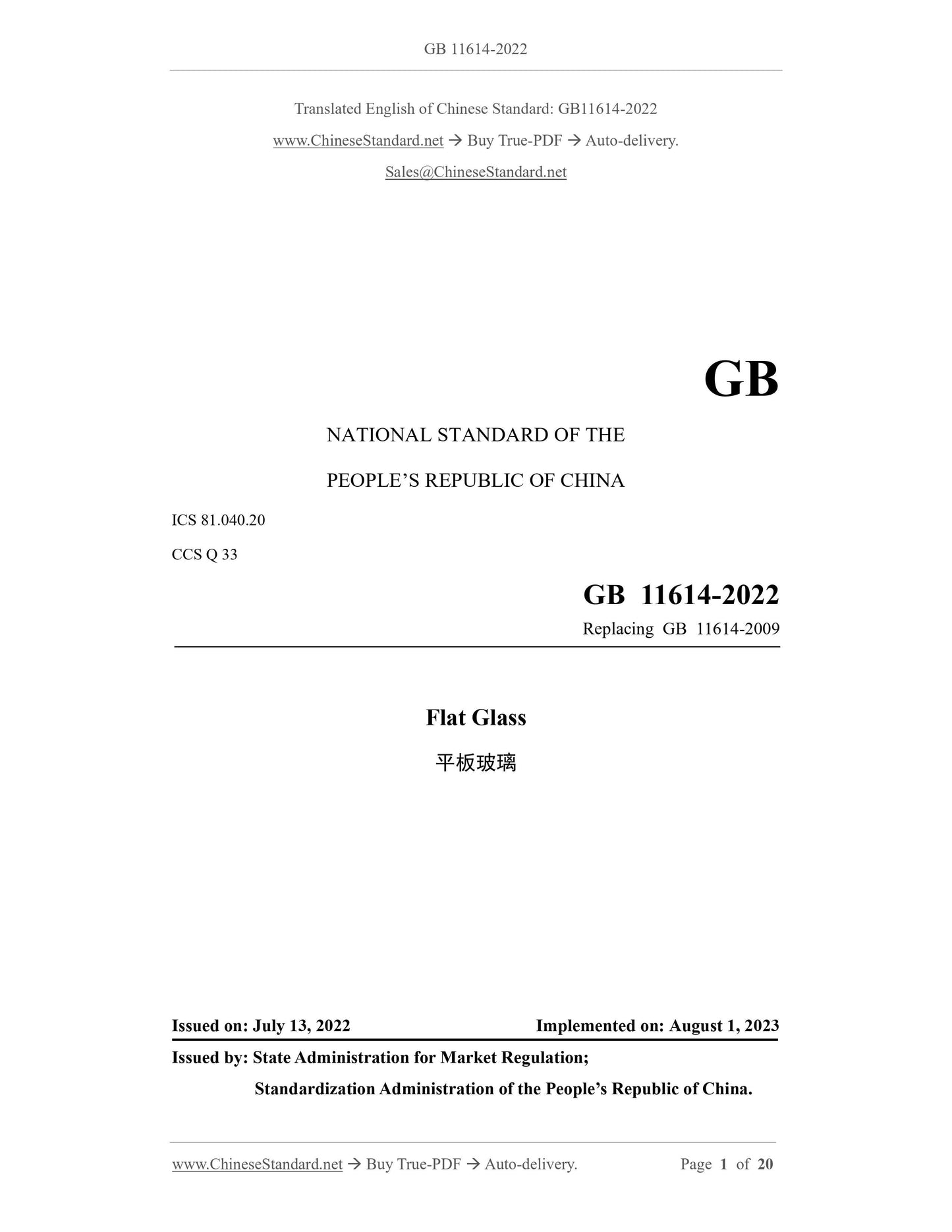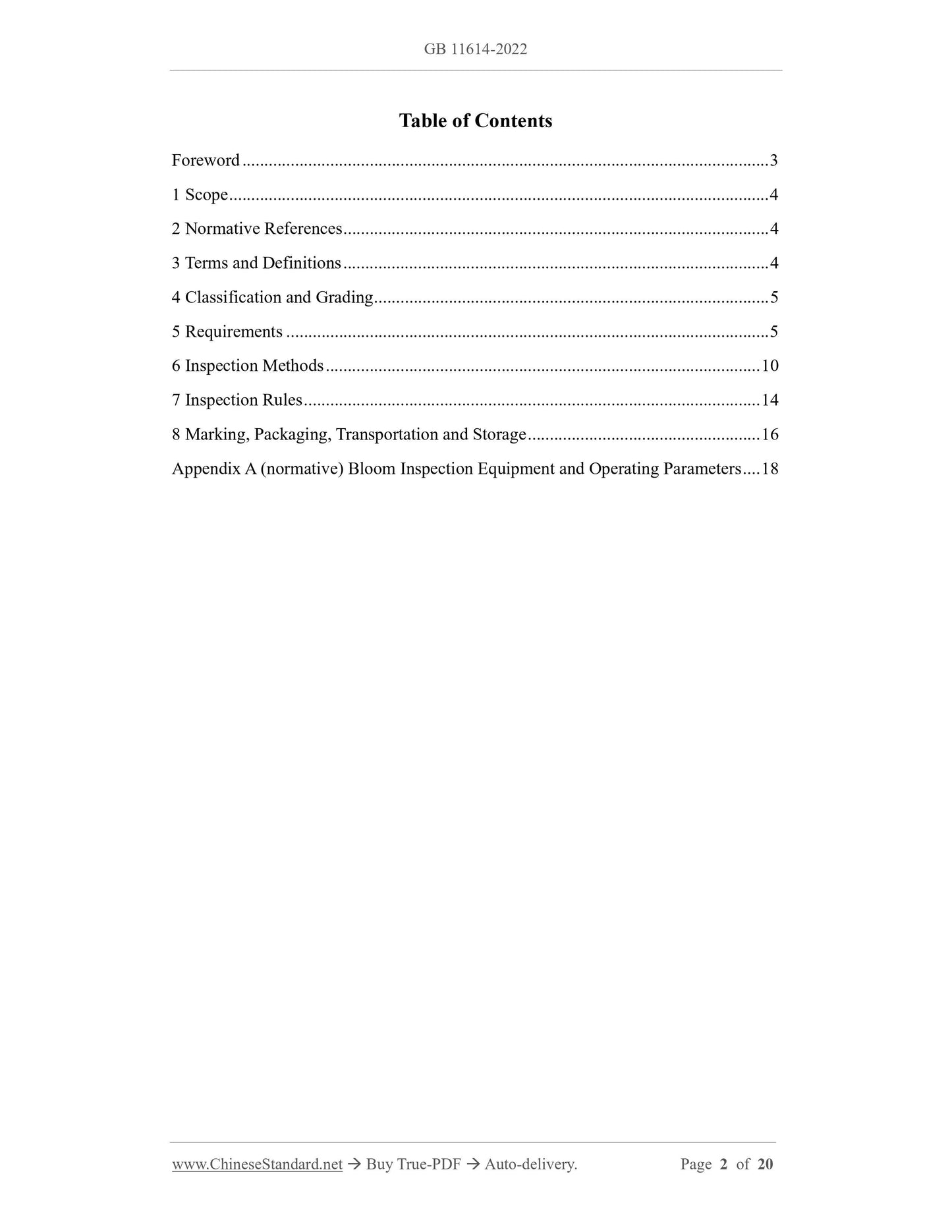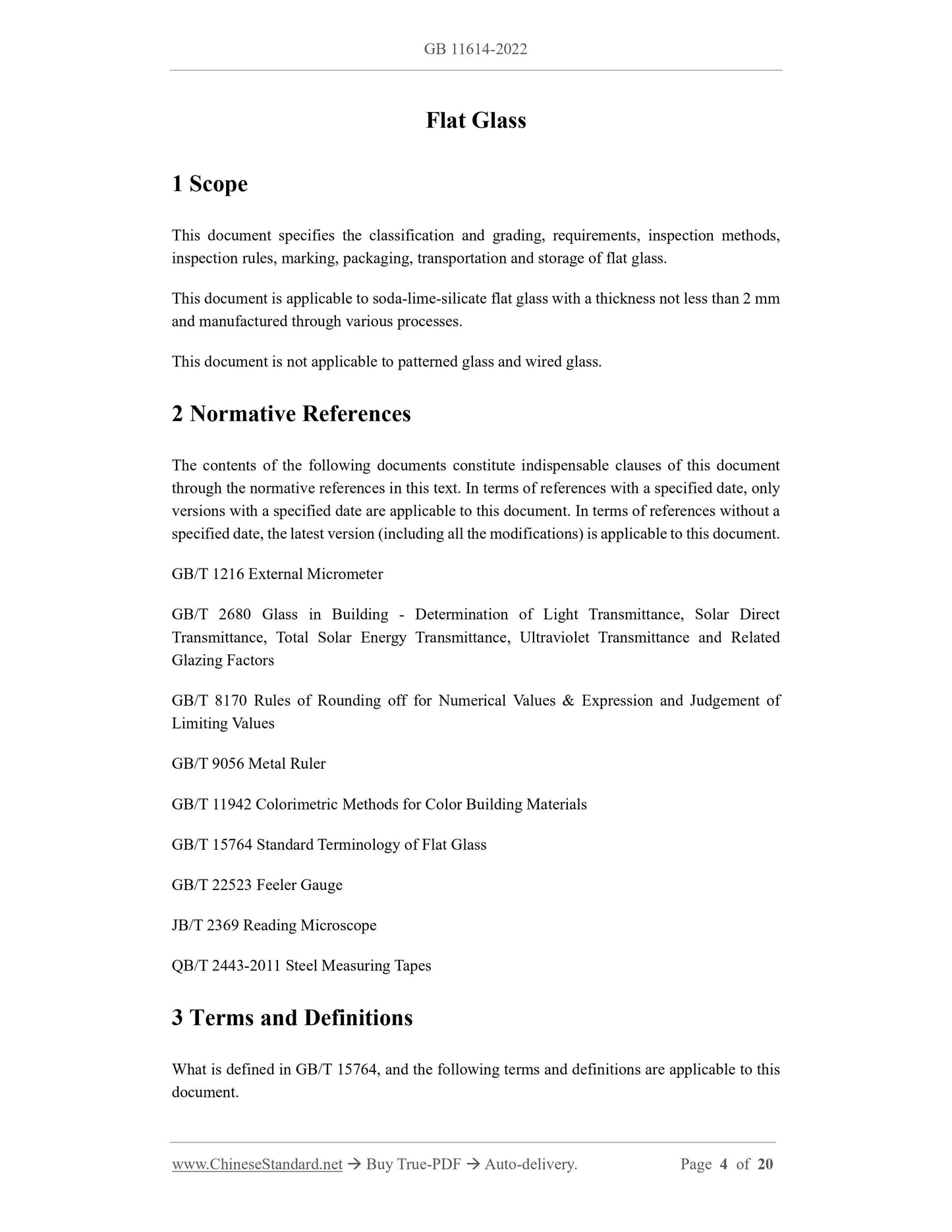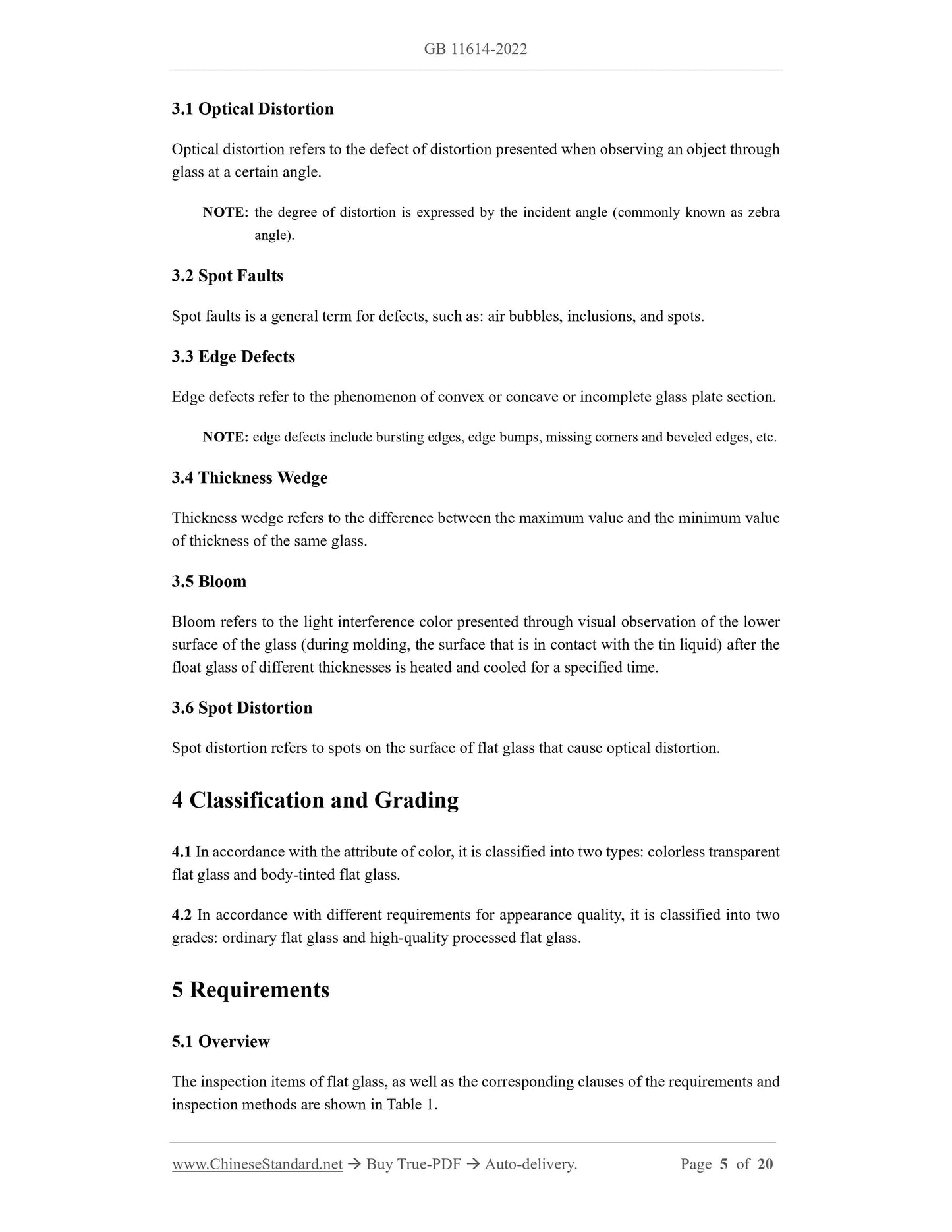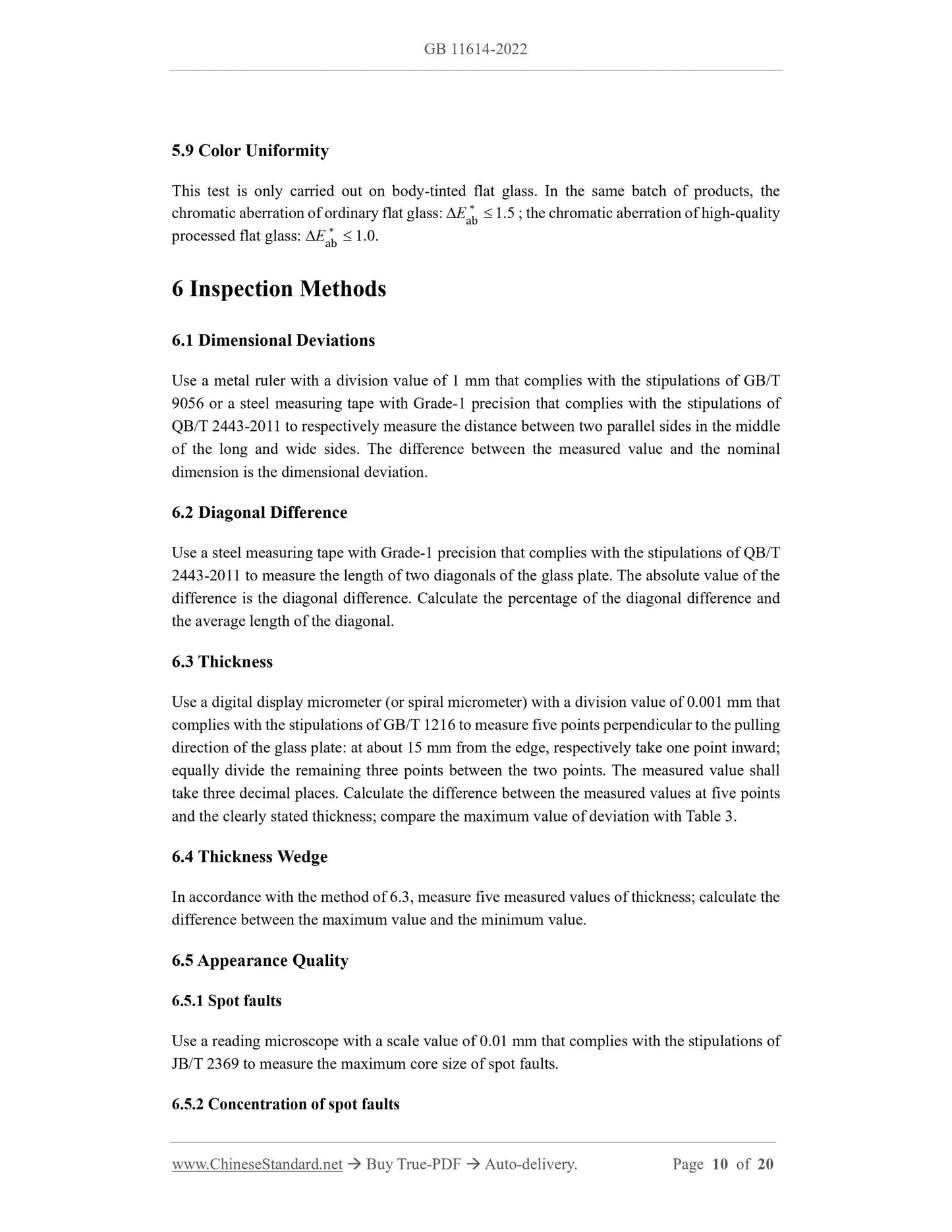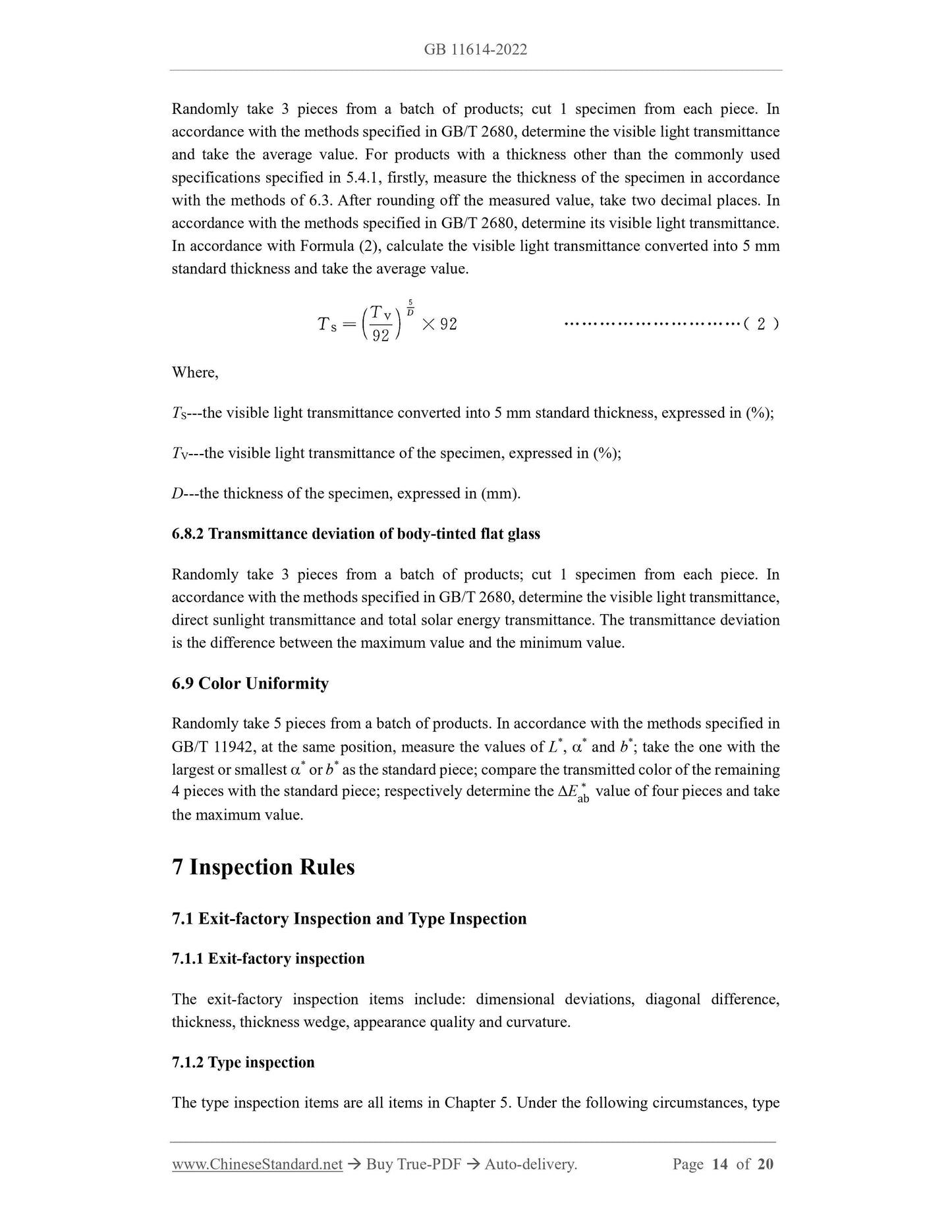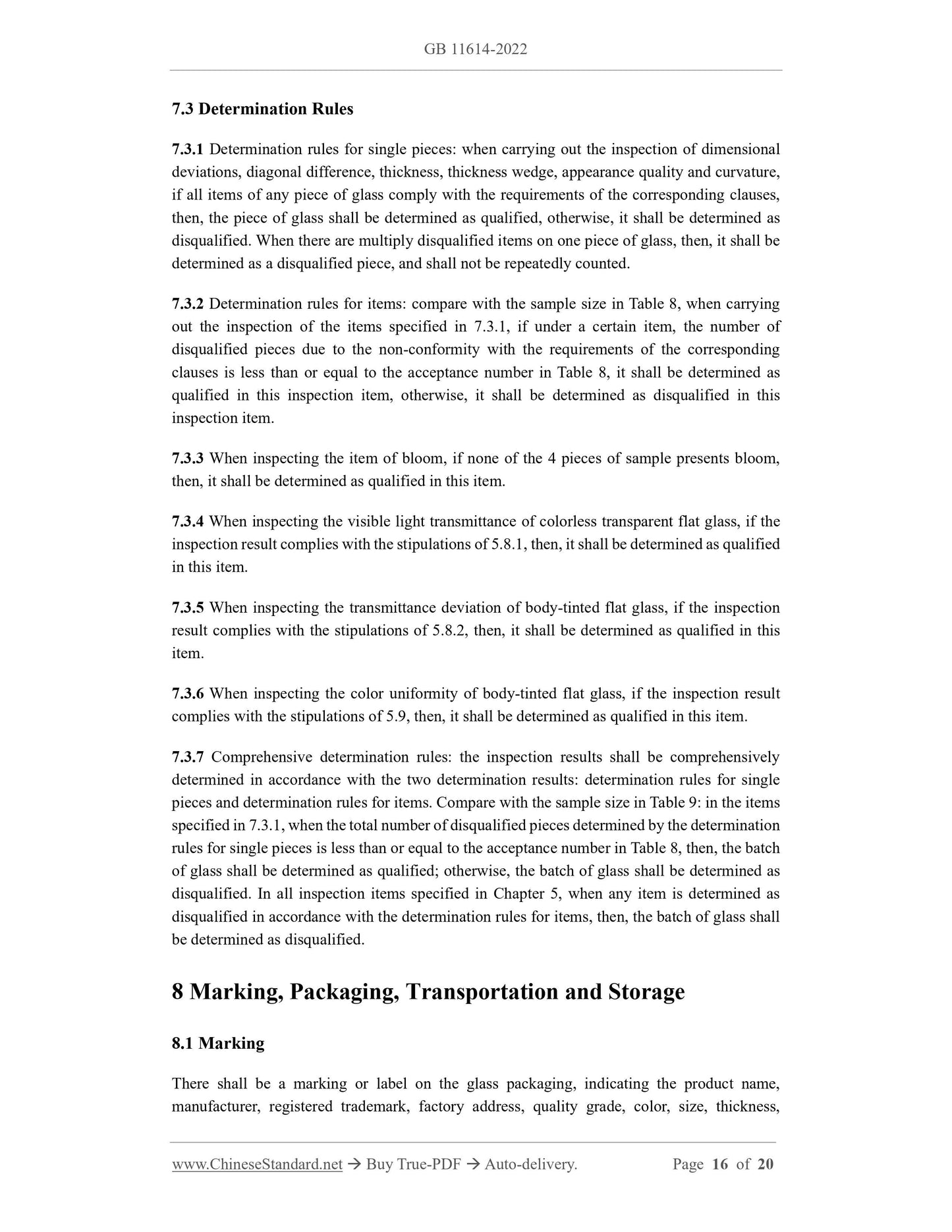1
/
of
7
www.ChineseStandard.us -- Field Test Asia Pte. Ltd.
GB 11614-2022 English PDF
GB 11614-2022 English PDF
Regular price
$275.00
Regular price
Sale price
$275.00
Unit price
/
per
Shipping calculated at checkout.
Couldn't load pickup availability
GB 11614-2022: Flat glass
Delivery: 9 seconds. Download (& Email) true-PDF + Invoice.
Get Quotation: Click GB 11614-2022 (Self-service in 1-minute)
Historical versions (Master-website): GB 11614-2022
Preview True-PDF (Reload/Scroll-down if blank)
GB 11614-2022
GB
NATIONAL STANDARD OF THE
PEOPLE’S REPUBLIC OF CHINA
ICS 81.040.20
CCS Q 33
Replacing GB 11614-2009
Flat Glass
平板玻璃
ISSUED ON: JULY 13, 2022
IMPLEMENTED ON: AUGUST 1, 2023
Issued by: State Administration for Market Regulation;
Standardization Administration of the People’s Republic of China.
Table of Contents
Foreword ... 3
1 Scope ... 4
2 Normative References ... 4
3 Terms and Definitions ... 4
4 Classification and Grading ... 5
5 Requirements ... 5
6 Inspection Methods ... 10
7 Inspection Rules ... 14
8 Marking, Packaging, Transportation and Storage ... 16
Appendix A (normative) Bloom Inspection Equipment and Operating Parameters ... 18
Flat Glass
1 Scope
This document specifies the classification and grading, requirements, inspection methods,
inspection rules, marking, packaging, transportation and storage of flat glass.
This document is applicable to soda-lime-silicate flat glass with a thickness not less than 2 mm
and manufactured through various processes.
This document is not applicable to patterned glass and wired glass.
2 Normative References
The contents of the following documents constitute indispensable clauses of this document
through the normative references in this text. In terms of references with a specified date, only
versions with a specified date are applicable to this document. In terms of references without a
specified date, the latest version (including all the modifications) is applicable to this document.
GB/T 1216 External Micrometer
GB/T 2680 Glass in Building - Determination of Light Transmittance, Solar Direct
Transmittance, Total Solar Energy Transmittance, Ultraviolet Transmittance and Related
Glazing Factors
GB/T 8170 Rules of Rounding off for Numerical Values and Expression and Judgement of
Limiting Values
GB/T 9056 Metal Ruler
GB/T 11942 Colorimetric Methods for Color Building Materials
GB/T 15764 Standard Terminology of Flat Glass
GB/T 22523 Feeler Gauge
JB/T 2369 Reading Microscope
QB/T 2443-2011 Steel Measuring Tapes
3 Terms and Definitions
What is defined in GB/T 15764, and the following terms and definitions are applicable to this
document.
3.1 Optical Distortion
Optical distortion refers to the defect of distortion presented when observing an object through
glass at a certain angle.
NOTE: the degree of distortion is expressed by the incident angle (commonly known as zebra
angle).
3.2 Spot Faults
Spot faults is a general term for defects, such as: air bubbles, inclusions, and spots.
3.3 Edge Defects
Edge defects refer to the phenomenon of convex or concave or incomplete glass plate section.
NOTE: edge defects include bursting edges, edge bumps, missing corners and beveled edges, etc.
3.4 Thickness Wedge
Thickness wedge refers to the difference between the maximum value and the minimum value
of thickness of the same glass.
3.5 Bloom
Bloom refers to the light interference color presented through visual observation of the lower
surface of the glass (during molding, the surface that is in contact with the tin liquid) after the
float glass of different thicknesses is heated and cooled for a specified time.
3.6 Spot Distortion
Spot distortion refers to spots on the surface of flat glass that cause optical distortion.
4 Classification and Grading
4.1 In accordance with the attribute of color, it is classified into two types: colorless transparent
flat glass and body-tinted flat glass.
4.2 In accordance with different requirements for appearance quality, it is classified into two
grades: ordinary flat glass and high-quality processed flat glass.
5 Requirements
5.1 Overview
The inspection items of flat glass, as well as the corresponding clauses of the requirements and
inspection methods are shown in Table 1.
5.9 Color Uniformity
This test is only carried out on body-tinted flat glass. In the same batch of products, the
chromatic aberration of ordinary flat glass: E ∗ab 1.5 ; the chromatic aberration of high-quality
processed flat glass: E ∗ab 1.0.
6 Inspection Methods
6.1 Dimensional Deviations
Use a metal ruler with a division value of 1 mm that complies with the stipulations of GB/T
9056 or a steel measuring tape with Grade-1 precision that complies with the stipulations of
QB/T 2443-2011 to respectively measure the distance between two parallel sides in the middle
of the long and wide sides. The difference between the measured value and the nominal
dimension is the dimensional deviation.
6.2 Diagonal Difference
Use a steel measuring tape with Grade-1 precision that complies with the stipulations of QB/T
2443-2011 to measure the length of two diagonals of the glass plate. The absolute value of the
difference is the diagonal difference. Calculate the percentage of the diagonal difference and
the average length of the diagonal.
6.3 Thickness
Use a digital display micrometer (or spiral micrometer) with a division value of 0.001 mm that
complies with the stipulations of GB/T 1216 to measure five points perpendicular to the pulling
direction of the glass plate: at about 15 mm from the edge, respectively take one point inward;
equally divide the remaining three points between the two points. The measured value shall
take three decimal places. Calculate the difference between the measured values at five points
and the clearly stated thickness; compare the maximum value of deviation with Table 3.
6.4 Thickness Wedge
In accordance with the method of 6.3, measure five measured values of thickness; calculate the
difference between the maximum value and the minimum value.
6.5 Appearance Quality
6.5.1 Spot faults
Use a reading microscope with a scale value of 0.01 mm that complies with the stipulations of
JB/T 2369 to measure the maximum core size of spot faults.
6.5.2 Concentration of spot faults
Randomly take 3 pieces from a batch of products; cut 1 specimen from each piece. In
accordance with the methods specified in GB/T 2680, determine the visible light transmittance
and take the average value. For products with a thickness other than the commonly used
specifications specified in 5.4.1, firstly, measure the thickness of the specimen in accordance
with the methods of 6.3. After rounding off the measured value, take two decimal places. In
accordance with the methods specified in GB/T 2680, determine its visible light transmittance.
In accordance with Formula (2), calculate the visible light transmittance converted into 5 mm
standard thickness and take the average value.
Where,
TS---the visible light transmittance converted into 5 mm standard thickness, expressed in (%);
TV---the visible light transmittance of the specimen, expressed in (%);
D---the thickness of the specimen, expressed in (mm).
6.8.2 Transmittance deviation of body-tinted flat glass
Randomly take 3 pieces from a batch of products; cut 1 specimen from each piece. In
accordance with the methods specified in GB/T 2680, determine the visible light transmittance,
direct sunlight transmittance and total solar energy transmittance. The transmittance deviation
is the difference between the maximum value and the minimum value.
6.9 Color Uniformity
Randomly take 5 pieces from a batch of products. In accordance with the methods specified in
GB/T 11942, at the same position, measure the values of L*, * and b*; take the one with the
largest or smallest * or b* as the standard piece; compare the transmitted color of the remaining
4 pieces with the standard piece; respectively determine the E ∗ab value of four pieces and take
the maximum value.
7 Inspection Rules
7.1 Exit-factory Inspection and Type Inspection
7.1.1 Exit-factory inspection
The exit-factory inspection items include: dimensional deviations, diagonal difference,
thickness, thickness wedge, appearance quality and curvature.
7.1.2 Type inspection
The type inspection items are all items in Chapter 5. Under the following circumstances, type
7.3 Determination Rules
7.3.1 Determination rules for single pieces: when carrying out the inspection of dimensional
deviations, diagonal difference, thickness, thickness wedge, appearance quality and curvature,
if all items of any piece of glass comply with the requirements of the corresponding clauses,
then, the piece of glass shall be determined as qualified, otherwise, it shall be determined as
disqualified. When there are multiply disqualified items on one piece of glass, then, it shall be
determined as a disqualified piece, and shall not be repeatedly counted.
7.3.2 Determination rules for items: compare with the sample size in Table 8, when carrying
out the inspection of the items specified in 7.3.1, if under a certain item, the number of
disqualified pieces due to the non-conformity with the requirements of the corresponding
clauses is less than or equal to the acceptance number in Table 8, it shall be determined as
qualified in this inspection item, otherwise, it shall be determined as disqualified in this
inspection item.
7.3.3 When inspecting the item of bloom, if none of the 4 pieces of sample presents bloom,
then, it shall be determined as qualified in this item.
7.3.4 When inspecting the visible light transmittance of colorless transparent flat glass, if the
inspection result complies with the stipulations of 5.8.1, then, it shall be determined as qualified
in this item.
7.3.5 When inspecting the transmittance deviation of body-tinted flat glass, if the inspection
result complies with the stipulations of 5.8.2, then, it shall be determined as qualified in this
item.
7.3.6 When inspecting the color uniformity of body-tinted flat glass, if the inspection result
complies with the stipulations of 5.9, then, it shall be determined as qualified in this item.
7.3.7 Comprehensive determination rules: the inspection results shall be comprehensively
determined in accordance with the two determination results: determination rules for single
pieces and determination rules for items. Compare with the sample size in Table 9: in the items
specified in 7.3.1, when the total number of disqualified pieces determined by the determination
rules for single pieces is less than or equal to the acceptance number in Table 8, then, the batch
of glass shall be determined as qualified; otherwise, the batch of glass shall be determined as
disqualified. In all inspection items specified in Chapter 5, when any item is determined as
disqualified in accordance with the determination rules for items, then, the batch of glass shall
be determined as disqualified.
8 Marking, Packaging, Transportation and Storage
8.1 Marking
There shall be a marking or label on the glass packaging, indicating the product name,
manufacturer, registered trademark, factory address, quality grade, color, size, thickness,
GB 11614-2022
GB
NATIONAL STANDARD OF THE
PEOPLE’S REPUBLIC OF CHINA
ICS 81.040.20
CCS Q 33
Replacing GB 11614-2009
Flat Glass
平板玻璃
ISSUED ON: JULY 13, 2022
IMPLEMENTED ON: AUGUST 1, 2023
Issued by: State Administration for Market Regulation;
Standardization Administration of the People’s Republic of China.
Table of Contents
Foreword ... 3
1 Scope ... 4
2 Normative References ... 4
3 Terms and Definitions ... 4
4 Classification and Grading ... 5
5 Requirements ... 5
6 Inspection Methods ... 10
7 Inspection Rules ... 14
8 Marking, Packaging, Transportation and Storage ... 16
Appendix A (normative) Bloom Inspection Equipment and Operating Parameters ... 18
Flat Glass
1 Scope
This document specifies the classification and grading, requirements, inspection methods,
inspection rules, marking, packaging, transportation and storage of flat glass.
This document is applicable to soda-lime-silicate flat glass with a thickness not less than 2 mm
and manufactured through various processes.
This document is not applicable to patterned glass and wired glass.
2 Normative References
The contents of the following documents constitute indispensable clauses of this document
through the normative references in this text. In terms of references with a specified date, only
versions with a specified date are applicable to this document. In terms of references without a
specified date, the latest version (including all the modifications) is applicable to this document.
GB/T 1216 External Micrometer
GB/T 2680 Glass in Building - Determination of Light Transmittance, Solar Direct
Transmittance, Total Solar Energy Transmittance, Ultraviolet Transmittance and Related
Glazing Factors
GB/T 8170 Rules of Rounding off for Numerical Values and Expression and Judgement of
Limiting Values
GB/T 9056 Metal Ruler
GB/T 11942 Colorimetric Methods for Color Building Materials
GB/T 15764 Standard Terminology of Flat Glass
GB/T 22523 Feeler Gauge
JB/T 2369 Reading Microscope
QB/T 2443-2011 Steel Measuring Tapes
3 Terms and Definitions
What is defined in GB/T 15764, and the following terms and definitions are applicable to this
document.
3.1 Optical Distortion
Optical distortion refers to the defect of distortion presented when observing an object through
glass at a certain angle.
NOTE: the degree of distortion is expressed by the incident angle (commonly known as zebra
angle).
3.2 Spot Faults
Spot faults is a general term for defects, such as: air bubbles, inclusions, and spots.
3.3 Edge Defects
Edge defects refer to the phenomenon of convex or concave or incomplete glass plate section.
NOTE: edge defects include bursting edges, edge bumps, missing corners and beveled edges, etc.
3.4 Thickness Wedge
Thickness wedge refers to the difference between the maximum value and the minimum value
of thickness of the same glass.
3.5 Bloom
Bloom refers to the light interference color presented through visual observation of the lower
surface of the glass (during molding, the surface that is in contact with the tin liquid) after the
float glass of different thicknesses is heated and cooled for a specified time. <...
Delivery: 9 seconds. Download (& Email) true-PDF + Invoice.
Get Quotation: Click GB 11614-2022 (Self-service in 1-minute)
Historical versions (Master-website): GB 11614-2022
Preview True-PDF (Reload/Scroll-down if blank)
GB 11614-2022
GB
NATIONAL STANDARD OF THE
PEOPLE’S REPUBLIC OF CHINA
ICS 81.040.20
CCS Q 33
Replacing GB 11614-2009
Flat Glass
平板玻璃
ISSUED ON: JULY 13, 2022
IMPLEMENTED ON: AUGUST 1, 2023
Issued by: State Administration for Market Regulation;
Standardization Administration of the People’s Republic of China.
Table of Contents
Foreword ... 3
1 Scope ... 4
2 Normative References ... 4
3 Terms and Definitions ... 4
4 Classification and Grading ... 5
5 Requirements ... 5
6 Inspection Methods ... 10
7 Inspection Rules ... 14
8 Marking, Packaging, Transportation and Storage ... 16
Appendix A (normative) Bloom Inspection Equipment and Operating Parameters ... 18
Flat Glass
1 Scope
This document specifies the classification and grading, requirements, inspection methods,
inspection rules, marking, packaging, transportation and storage of flat glass.
This document is applicable to soda-lime-silicate flat glass with a thickness not less than 2 mm
and manufactured through various processes.
This document is not applicable to patterned glass and wired glass.
2 Normative References
The contents of the following documents constitute indispensable clauses of this document
through the normative references in this text. In terms of references with a specified date, only
versions with a specified date are applicable to this document. In terms of references without a
specified date, the latest version (including all the modifications) is applicable to this document.
GB/T 1216 External Micrometer
GB/T 2680 Glass in Building - Determination of Light Transmittance, Solar Direct
Transmittance, Total Solar Energy Transmittance, Ultraviolet Transmittance and Related
Glazing Factors
GB/T 8170 Rules of Rounding off for Numerical Values and Expression and Judgement of
Limiting Values
GB/T 9056 Metal Ruler
GB/T 11942 Colorimetric Methods for Color Building Materials
GB/T 15764 Standard Terminology of Flat Glass
GB/T 22523 Feeler Gauge
JB/T 2369 Reading Microscope
QB/T 2443-2011 Steel Measuring Tapes
3 Terms and Definitions
What is defined in GB/T 15764, and the following terms and definitions are applicable to this
document.
3.1 Optical Distortion
Optical distortion refers to the defect of distortion presented when observing an object through
glass at a certain angle.
NOTE: the degree of distortion is expressed by the incident angle (commonly known as zebra
angle).
3.2 Spot Faults
Spot faults is a general term for defects, such as: air bubbles, inclusions, and spots.
3.3 Edge Defects
Edge defects refer to the phenomenon of convex or concave or incomplete glass plate section.
NOTE: edge defects include bursting edges, edge bumps, missing corners and beveled edges, etc.
3.4 Thickness Wedge
Thickness wedge refers to the difference between the maximum value and the minimum value
of thickness of the same glass.
3.5 Bloom
Bloom refers to the light interference color presented through visual observation of the lower
surface of the glass (during molding, the surface that is in contact with the tin liquid) after the
float glass of different thicknesses is heated and cooled for a specified time.
3.6 Spot Distortion
Spot distortion refers to spots on the surface of flat glass that cause optical distortion.
4 Classification and Grading
4.1 In accordance with the attribute of color, it is classified into two types: colorless transparent
flat glass and body-tinted flat glass.
4.2 In accordance with different requirements for appearance quality, it is classified into two
grades: ordinary flat glass and high-quality processed flat glass.
5 Requirements
5.1 Overview
The inspection items of flat glass, as well as the corresponding clauses of the requirements and
inspection methods are shown in Table 1.
5.9 Color Uniformity
This test is only carried out on body-tinted flat glass. In the same batch of products, the
chromatic aberration of ordinary flat glass: E ∗ab 1.5 ; the chromatic aberration of high-quality
processed flat glass: E ∗ab 1.0.
6 Inspection Methods
6.1 Dimensional Deviations
Use a metal ruler with a division value of 1 mm that complies with the stipulations of GB/T
9056 or a steel measuring tape with Grade-1 precision that complies with the stipulations of
QB/T 2443-2011 to respectively measure the distance between two parallel sides in the middle
of the long and wide sides. The difference between the measured value and the nominal
dimension is the dimensional deviation.
6.2 Diagonal Difference
Use a steel measuring tape with Grade-1 precision that complies with the stipulations of QB/T
2443-2011 to measure the length of two diagonals of the glass plate. The absolute value of the
difference is the diagonal difference. Calculate the percentage of the diagonal difference and
the average length of the diagonal.
6.3 Thickness
Use a digital display micrometer (or spiral micrometer) with a division value of 0.001 mm that
complies with the stipulations of GB/T 1216 to measure five points perpendicular to the pulling
direction of the glass plate: at about 15 mm from the edge, respectively take one point inward;
equally divide the remaining three points between the two points. The measured value shall
take three decimal places. Calculate the difference between the measured values at five points
and the clearly stated thickness; compare the maximum value of deviation with Table 3.
6.4 Thickness Wedge
In accordance with the method of 6.3, measure five measured values of thickness; calculate the
difference between the maximum value and the minimum value.
6.5 Appearance Quality
6.5.1 Spot faults
Use a reading microscope with a scale value of 0.01 mm that complies with the stipulations of
JB/T 2369 to measure the maximum core size of spot faults.
6.5.2 Concentration of spot faults
Randomly take 3 pieces from a batch of products; cut 1 specimen from each piece. In
accordance with the methods specified in GB/T 2680, determine the visible light transmittance
and take the average value. For products with a thickness other than the commonly used
specifications specified in 5.4.1, firstly, measure the thickness of the specimen in accordance
with the methods of 6.3. After rounding off the measured value, take two decimal places. In
accordance with the methods specified in GB/T 2680, determine its visible light transmittance.
In accordance with Formula (2), calculate the visible light transmittance converted into 5 mm
standard thickness and take the average value.
Where,
TS---the visible light transmittance converted into 5 mm standard thickness, expressed in (%);
TV---the visible light transmittance of the specimen, expressed in (%);
D---the thickness of the specimen, expressed in (mm).
6.8.2 Transmittance deviation of body-tinted flat glass
Randomly take 3 pieces from a batch of products; cut 1 specimen from each piece. In
accordance with the methods specified in GB/T 2680, determine the visible light transmittance,
direct sunlight transmittance and total solar energy transmittance. The transmittance deviation
is the difference between the maximum value and the minimum value.
6.9 Color Uniformity
Randomly take 5 pieces from a batch of products. In accordance with the methods specified in
GB/T 11942, at the same position, measure the values of L*, * and b*; take the one with the
largest or smallest * or b* as the standard piece; compare the transmitted color of the remaining
4 pieces with the standard piece; respectively determine the E ∗ab value of four pieces and take
the maximum value.
7 Inspection Rules
7.1 Exit-factory Inspection and Type Inspection
7.1.1 Exit-factory inspection
The exit-factory inspection items include: dimensional deviations, diagonal difference,
thickness, thickness wedge, appearance quality and curvature.
7.1.2 Type inspection
The type inspection items are all items in Chapter 5. Under the following circumstances, type
7.3 Determination Rules
7.3.1 Determination rules for single pieces: when carrying out the inspection of dimensional
deviations, diagonal difference, thickness, thickness wedge, appearance quality and curvature,
if all items of any piece of glass comply with the requirements of the corresponding clauses,
then, the piece of glass shall be determined as qualified, otherwise, it shall be determined as
disqualified. When there are multiply disqualified items on one piece of glass, then, it shall be
determined as a disqualified piece, and shall not be repeatedly counted.
7.3.2 Determination rules for items: compare with the sample size in Table 8, when carrying
out the inspection of the items specified in 7.3.1, if under a certain item, the number of
disqualified pieces due to the non-conformity with the requirements of the corresponding
clauses is less than or equal to the acceptance number in Table 8, it shall be determined as
qualified in this inspection item, otherwise, it shall be determined as disqualified in this
inspection item.
7.3.3 When inspecting the item of bloom, if none of the 4 pieces of sample presents bloom,
then, it shall be determined as qualified in this item.
7.3.4 When inspecting the visible light transmittance of colorless transparent flat glass, if the
inspection result complies with the stipulations of 5.8.1, then, it shall be determined as qualified
in this item.
7.3.5 When inspecting the transmittance deviation of body-tinted flat glass, if the inspection
result complies with the stipulations of 5.8.2, then, it shall be determined as qualified in this
item.
7.3.6 When inspecting the color uniformity of body-tinted flat glass, if the inspection result
complies with the stipulations of 5.9, then, it shall be determined as qualified in this item.
7.3.7 Comprehensive determination rules: the inspection results shall be comprehensively
determined in accordance with the two determination results: determination rules for single
pieces and determination rules for items. Compare with the sample size in Table 9: in the items
specified in 7.3.1, when the total number of disqualified pieces determined by the determination
rules for single pieces is less than or equal to the acceptance number in Table 8, then, the batch
of glass shall be determined as qualified; otherwise, the batch of glass shall be determined as
disqualified. In all inspection items specified in Chapter 5, when any item is determined as
disqualified in accordance with the determination rules for items, then, the batch of glass shall
be determined as disqualified.
8 Marking, Packaging, Transportation and Storage
8.1 Marking
There shall be a marking or label on the glass packaging, indicating the product name,
manufacturer, registered trademark, factory address, quality grade, color, size, thickness,
GB 11614-2022
GB
NATIONAL STANDARD OF THE
PEOPLE’S REPUBLIC OF CHINA
ICS 81.040.20
CCS Q 33
Replacing GB 11614-2009
Flat Glass
平板玻璃
ISSUED ON: JULY 13, 2022
IMPLEMENTED ON: AUGUST 1, 2023
Issued by: State Administration for Market Regulation;
Standardization Administration of the People’s Republic of China.
Table of Contents
Foreword ... 3
1 Scope ... 4
2 Normative References ... 4
3 Terms and Definitions ... 4
4 Classification and Grading ... 5
5 Requirements ... 5
6 Inspection Methods ... 10
7 Inspection Rules ... 14
8 Marking, Packaging, Transportation and Storage ... 16
Appendix A (normative) Bloom Inspection Equipment and Operating Parameters ... 18
Flat Glass
1 Scope
This document specifies the classification and grading, requirements, inspection methods,
inspection rules, marking, packaging, transportation and storage of flat glass.
This document is applicable to soda-lime-silicate flat glass with a thickness not less than 2 mm
and manufactured through various processes.
This document is not applicable to patterned glass and wired glass.
2 Normative References
The contents of the following documents constitute indispensable clauses of this document
through the normative references in this text. In terms of references with a specified date, only
versions with a specified date are applicable to this document. In terms of references without a
specified date, the latest version (including all the modifications) is applicable to this document.
GB/T 1216 External Micrometer
GB/T 2680 Glass in Building - Determination of Light Transmittance, Solar Direct
Transmittance, Total Solar Energy Transmittance, Ultraviolet Transmittance and Related
Glazing Factors
GB/T 8170 Rules of Rounding off for Numerical Values and Expression and Judgement of
Limiting Values
GB/T 9056 Metal Ruler
GB/T 11942 Colorimetric Methods for Color Building Materials
GB/T 15764 Standard Terminology of Flat Glass
GB/T 22523 Feeler Gauge
JB/T 2369 Reading Microscope
QB/T 2443-2011 Steel Measuring Tapes
3 Terms and Definitions
What is defined in GB/T 15764, and the following terms and definitions are applicable to this
document.
3.1 Optical Distortion
Optical distortion refers to the defect of distortion presented when observing an object through
glass at a certain angle.
NOTE: the degree of distortion is expressed by the incident angle (commonly known as zebra
angle).
3.2 Spot Faults
Spot faults is a general term for defects, such as: air bubbles, inclusions, and spots.
3.3 Edge Defects
Edge defects refer to the phenomenon of convex or concave or incomplete glass plate section.
NOTE: edge defects include bursting edges, edge bumps, missing corners and beveled edges, etc.
3.4 Thickness Wedge
Thickness wedge refers to the difference between the maximum value and the minimum value
of thickness of the same glass.
3.5 Bloom
Bloom refers to the light interference color presented through visual observation of the lower
surface of the glass (during molding, the surface that is in contact with the tin liquid) after the
float glass of different thicknesses is heated and cooled for a specified time. <...
Share
